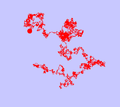- Microrheology
-
Microrheology[1] is a technique to measure the rheological properties of a medium, such as microviscosity, via the measurement of the trajectory of a flow tracer (a micrometre-size particle). It is a new way of doing rheology, traditionally done using a rheometer. The size of the tracer is around a micrometre. There are two types of microrheology: passive microrheology and active microrheology. Passive microrheology uses inherent thermal energy to move the tracers, whereas active microrheology uses externally applied forces, such as from a magnetic field or an optical tweezer, to do so.
Contents
Passive microrheology
Passive microrheology uses the thermal energy (kT) to move the tracers. The trajectories of the tracers are measured optically either by microscopy or by diffusing-wave spectroscopy (DWS). From the mean square displacement with respect to time (noted MSD or <Δr2> ), one can calculate the visco-elastic moduli G′(ω) and G″(ω) using the generalized Stokes–Einstein relation (GSER). Here is a view of the trajectory of a particle of micrometer size.
Observing the MSD for a wide range of time scales gives information on the microstructure of the medium where are diffusing the tracers. If the tracers are having a free diffusion, on can deduce that the medium is purely viscous. If the tracers are having a sub-diffusive mean trajectory, it indicates that the medium presents some viscoelastic properties. For example, in a polymer network, the tracer may be trapped. The excursion δ of the tracer is related to the elastic modulus G′ with the relation G′ = kBT/(6πaδ2).[2]
Microrheology is another way to do linear rheology. Since the force involved is very weak (order of 10−15 N), microrheology garanty to be in the so-called linear region of the strain/stress relationship. It is also able to measure very small volumes (biological cell).
Given the complex viscoelastic modulus
 with G′(ω) dissipative part and G″(ω) the conservative part and ω=2πf the pulsation. The GSER is as follow:
with G′(ω) dissipative part and G″(ω) the conservative part and ω=2πf the pulsation. The GSER is as follow:with
 : Laplace transform of G
: Laplace transform of G- kB: Boltzmann constant
- T: temperature in kelvins
- s: the Laplace frequency
- a: the radius of the tracer
 : the Laplace transform of the mean square displacement
: the Laplace transform of the mean square displacement
Active microrheology
Active microrheology may use a magnetic field [3][4][5][6][7] or optical tweezers[8] to apply a force on the tracer and then find the stress/strain relation.
References
- ^ Mason Weitz (1995). Physical Review Letters 74: 7.
- ^ European Physical Journal E 8: 431–436. 2002. Bibcode 2002EPJE....8..431B. doi:10.1140/epje/i2002-10026-0.
- ^ A.R. Bausch et al. (1999). "Measurement of Local Viscoelasticity and Forces in Living Cells by Magnetic Tweezers". Biophysical Journal 76: 573. Bibcode 1999BpJ....76..573B. doi:10.1016/S0006-3495(99)77225-5. PMID 9876170.
- ^ K.S. Zaner and P.A. Valberg (1989). "Viscoelasticity of F-actin measured with magnetic microparticles". Journal of Cell Biology 109: 2233. doi:10.1083/jcb.109.5.2233. PMID 2808527.
- ^ F.Ziemann, J. Radler, and E. Sackmann (1994). "Local measurements of viscoelastic moduli of entangled actin networks using an oscillating magnetic bead micro-rheometer". Biophysical Journal 66: 2210. Bibcode 1994BpJ....66.2210Z. doi:10.1016/S0006-3495(94)81017-3. PMID 8075354.
- ^ F.G. Schmidt, F. Ziemann, and E. Sackmann (1996). European Biophysics Journal 24: 348.
- ^ F. Amblard et al. (1996). "Subdiffusion and Anomalous Local Viscoelasticity in Actin Networks". Physical Review Letters 77: 4470. Bibcode 1996PhRvL..77.4470A. doi:10.1103/PhysRevLett.77.4470. PMID 10062546.
- ^ E. Helfer et al. (2000). "Microrheology of Biopolymer-Membrane Complexes". Physical Review Letters 85: 457. Bibcode 2000PhRvL..85..457H. doi:10.1103/PhysRevLett.85.457. PMID 10991307.
External links
Categories:
Wikimedia Foundation. 2010.




